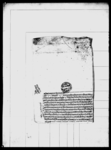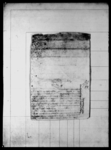A rukkā from King Rājendra to the Raṇasera Palṭan re the collection of animal hides (VS 1898)
ID: DNA_0015_0048
Edited and
translated by Astrid Zotter
in collaboration with
Raju Rimal
Created: 2018-09-29;
Last modified: 2024-01-16
For the metadata of the document, click here
The accompanying edition, translation/synopsis and/or commentary are available under the terms of the Creative Commons Attribution-ShareAlike 4.0 International License
Abstract
This rukkā orders the Raṇasera Palṭan to collect levies in the form of animal hides from certain groups in the region between the Kali Gandaki and the Marsyangdi rivers for the years VS 1898 and 1899 and deliver them to a military arsenal.Diplomatic edition
[1r]
1श्री\1श्रीरणसेर१2श्रीसिंहसार्दुलजं
3२
4श्रीगुरु
5३[royal seal]1स्वस्तिश्रमन्महाराजाधिराजकस्यरुक्का¯¯¯ ¯¯¯ ¯¯¯ ¯¯¯ ¯¯¯ ¯¯¯
2आगे¯ १¯ ¯ ¯पल्टन्प्रति¯ ¯ २ ¯ ¯कंपनीवुटव़ल्कोतहसिल्मालाग्दा•तस्कोसट्टातिमिहरू
3लेचेप्यामर्स्यान्दिपश्चीम्कालीपूर्वका¯३¯प्रोहित्भैवादगोतिया•चौतरिय़ा•काजीकपर्दार
4सर्दारसुवा•सुवेदारडिट्ठा•नजिकिजेठावुढा•विर्तव़ारवितलप्पामोहरिया•छाप्छप्पाली
5अमालिदारकानाउमा•आफनाआफनाअम्वलभरकाभोट्याकिरातिराइमझिय़ा•मुर्मिसि
6कारषेल्न्यासिनुषान्याजातकोघरहि१।१डिँगाभैसीवाघभालु•मृगकाछालाउघाइदिनु
7छालादिननसक्न्याकाघरमासार्किकामीकाघरवाट•आठआठआना•अरूजातकाघरवा
8टदुइदुइआनादामतहसिलगरिदिनुभंन्या•सालवसालीलालमोहरभय़ाको•तहसिलभै
9आये़नभनि•कपतान्मोहनवीरसाहीलेहाम्राहजुरमाविंतिपार्दा•जाहेरभय़ो•सालवसा
10लिलालमोहरवमोजीम्९८।९९सालसमेत्कोछालाआमदनितहसिलगरिजंगीमेगजी
11नमादाषीलगरि•सालसालकारसिदलीजान्यागरभंन्यावंदेजकोमोहरगरिवक्स्यौं
12येस्वंदेजमा•जोरहैनौ•अपसरिय़ाहौला•इतिसम्वत्१८९८सालमितिमाघवदि९रो
13ज६शुभ्म्¯¯¯¯ ¯¯¯¯ ¯¯¯¯ ¯¯¯¯ ¯¯¯¯ ¯¯¯¯ ¯¯¯¯
[1v]
1⟪(१[?])⟫1⟪५८५⟫1रुजुगुरूप्रसादसाहरुजुफत्त्यजंङ्गसाह2रुजुतारानाथअर्ज्याल्•
Translation
[1r]
Venerable Raṇasera – 1
Venerable Siṃha Sārdulajaṃ – 2
Venerable guru(s) – 3
Hail! [This is] an executive order (rukkā) of the supreme king of great kings.1
Āge: To the [venerable Raṇasera]2 Palṭan3
"As the venerable [Siṃha Sārdulajaṃ]4 Company5 has been assigned to revenue collection in Buṭavāla, in its stead you—on behalf of the [venerable guru(s)]6 , priests (purohita)7 , agnatic kin (bhayāda), those of the same gotra [as us] (gotiyā), cautariyās, kājīs, kapardāras, sardāras, subbās, subedāras, ḍiṭṭhās, near ones? (najiki)8 , jeṭhā-buḍhās, birtavāras, bitalapyās, mohariyās, chāpachapyālīs, amālidāras throughout their respective districts west of the Cepyā and Marsyāndi [rivers] and east of the Kālī [Gandakī River]—are to collect the hides of dead animals (ḍĩgā)9 —buffaloes, tigers, bears, deer—[at the rate of] 1 from each Bhoṭyā, Kirātī, Rāī, Majhiyā,10 [and] Murmi household, caste groups (jāta) who hunt (sikāra khelnyā) or eat [the meat of] dead animals (sinu khānyā)11 . In the case of households that cannot give a hide, revenue [in the form of] cash (dāma) is to be collected: eight ānās from each Sārkī12 and Kāmī household, [and] two ānās from each household of the other jātas." It has come to our notice, when Captain Mohana Vīra Sāhī made petition in our presence, that the revenue collection called for by the annual lālamohara [just] cited has not happened. We have [herewith] sealed the order (bandeja) for you to go and collect the hides for the years [18]98 and [18]99 as revenue according to [what is stipulated] in the annual lālamohara, deliver [them] to the [customary] military arsenal(s) (jaṅgī megajīna) [and] take receipts for the respective years. If you do not abide by this regulation you will be [considered as] rebels.
Friday, the 9th of the dark fortnight of Māgha of the [Vikrama] era year 1898 (2 April 1842).
[1v]
[no.] 58513
(physically) present (ruju): Gurūprasāda Sāha
ruju: Phattyajaṅga Sāha
ruju: Tārānātha Arjyāl
Commentary
Following a delay in revenue collection, the present executive order shifts the duty to collect the yearly owed quantity of animal hides in the area between the Kali Gandaki and the Marsyangdi rivers from the Siṃha Sardula Company, which had been reassigned to Butwal (south of the area designated in the present document) to the Raṇasera Palṭan.
Earlier documents of this type are covered in translation or as abstracts in the Regmi Research Series. Judging from its summary, one document, issued in VS 1865 (1808 CE) for a region west of the Kali and east of the Bheri, seems to have been addressed to a list of state functionaries similar to the one mentioned in the present one (Regmi 1987: 45). In it there is, however, no mention of the involvement of a military unit in the collection of the hides. Rather, it is said that the hides should be transported by jhārā labour. It furthermore stipulates that "each bhote, hunter, and sino-eating family" should supply one hide, whereas Sārkī families should supply two. Another document, issued in VS 1874 (1817 CE), referring to exactly the same area as the present document, names the same groups as the previous document and orders the Naya Sabuj Company to help the state functionaries carry out the collection (Regmi 1980). Thus over time the collection duties seem to have been shifted from civil functionaries to military personnel, and the groups obligated to provide the skins of animals seem to have been extended.
These documents testify to what was a general scheme for collecting animal hides for military purposes that M.C. Regmi found attested from 1794 CE onwards for different areas (Regmi 1971; Regmi 1975: 53–54; Regmi 1979a; Regmi 1979b). Hides were drawn from those communities who hunted wild animals or ate sino. These groups included "Bhote, Rai, Majhi, Murmi, Gurung, Chepang, Sunuwar, Hayu, Paheri, Baramu, and Thansi" (Regmi 1979b: 127), who had to deliver one hide per year or else pay a stipulated sum. The untouchable Sārkīs, whose traditional tasks also included the removal of dead animals, especially of such bovines as oxen and buffaloes, from their high-caste patrons’ households, and in the present document the Kāmīs, traditionally responsible for weaponry, seem to have had to deliver or pay at least double of what was expected from these ethnic communities.
Taxation on the hunting and eating of dead animals has been discussed as one of the ways in which certain groups’ divergent social practices were made a source of income for the state (Lecomte-Tilouine 2009: 299). Here groups were targeted whose livelihoods gave them access to animal hides, a commodity charged with impurity from a high-caste Hindu point of view, but needed by the state for weaponry. It seemed but right from the same high-caste perspective to tax hunters (i.e. persons who engaged in what was otherwise a royal privilege) and consumers of impure meat. Animals that died naturally or by accident rather than having been intentionally killed were regarded as inedible for higher castes. Regmi in his discussion of similar documents goes into the practice of eating sino flesh, discussing it in connection with the ban on the killing of cows, but he does not take up the question of hunting and the connection between the groups mentioned. Thus it remains unclear whether the arrangement targeted groups that either both hunted and ate sino flesh, or hunted or ate sino flesh, or else either of these plus certain tribal groups.


